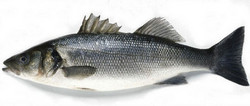
Polyculture of Seabass
Eitor/Mohamed Shihb
This type of culture approach shows great promise in reducing if not totally eliminating the farmers' dependence on trash fish as food source.
The method is achieved by simply incorporating a species of forage fish with the main species in the pond. The choince of forage fish will depend on its ability to reproduce continuously in quantity sufficient to sustain the growth of seabass throughout the culture period. The forage fish must be such a species that could make use of natural food produced in the pond and does not compete with the main species in terms of feeding habit such as Oreochromis mossambicus, Oreochromis niloticus, etc.
In polyculture, after the pond soil is neutralized, organic fertilizer (chicken manure) is applied at the rate of 1 ton per hectare. Then water depth is gradually increased for propagation of natural food. When abundance of natural food are observed, selected tilapia broodstocks are released to the pond at the rate of 5,000–10,000 per hectare. Sex ratio of male to female is 1:3. The tilapia are reared in pond for 1 to 2 months or until tilapia fry appear in sufficient number.Seabass juveniles are then stocked.
Seabass juveniles (8–10 cm in size) from nursery are stocked in the grow-out pond at the rate of 3000–5,000 per hectare in polyculture system. Prior to stocking, juveniles are acclimatized to pond culture and salinity conditions. Stocking the fish in uniform sizes will be most ideal and should be done at cooler times of the day.
Due to the need of maintaining natural food in ponds, water replenishment in polyculture system should be minimized. Water change should be done once in three days for about 50% of capacity.Supplementary feed is not required in this polyculture system.


ساحة النقاش